-
Product Name
Human PRNP/ALTPRP/PRIP/PRP recombinant protein
- Documents
-
Description
Major Prion Protein is unique in its ability to reproduce on its own and become infectious. The discovery of prion proteins as infectious agents began in the 1980s with an outbreak of mad cow disease in the United Kingdom. They are found in high quantity in the brain of humans and animals infected with neurodegenerative diseases known as transmissible spongiform encephalopathies or prion diseases. They can occur in two forms called PrP-sen and PrP-res. The normal, monomeric form has a mainly alpha-helical structure. The disease-associated, protease-resistant form forms amyloid fibrils containing a cross-beta spine, formed by a steric zipper of superposed beta-strands. Disease mutations may favor intermolecular contacts via short beta strands, and may thereby trigger oligomerization. Contains an N-terminal region composed of octamer repeats. Diseases caused by prions are known as spongiform diseases, because the brain tissue in infected individuals is filled with holes, giving it a sponge-like appearance. Although prions are found throughout the brain, the symptoms of spongiform diseases vary according to the regions. There are currently no effective treatments for spongiform diseases and all are fatal. Prions cannot be destroyed by boiling, alcohol, acid, standard autoclaving methods, or radiation. In fact, infected brains that have been sitting in formaldehyde for decades can still transmit spongiform disease.
-
Protein name
prion protein(PRNP)
-
Protein short names
ALTPRP; PRIP; PRP
-
Uniprot ID
P04156
-
Source/Expression Host
E. coli
-
Expression Plasmid/cDNA
A DNA sequence encoding the Human PRNP/ALTPRP/PRIP/PRP Gln91-Ser231 is expressed.
-
Protein Species
Human
-
Purity
>95% as determined by SDS-PAGE.
-
Validations

Human PRNP/ALTPRP/PRIP/PRP recombinant protein
Related Products / Services
Please note: All products are "FOR RESEARCH USE ONLY AND ARE NOT INTENDED FOR DIAGNOSTIC OR THERAPEUTIC USE"
